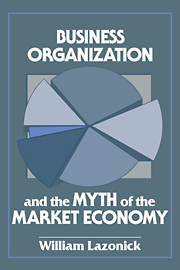Book contents
- Frontmatter
- Contents
- List of figures
- Acknowledgments
- Introduction: the wealth of three nations
- PART I Economic institutions and economic performance
- PART II Intellectual foundations and intellectual constraints
- PART III The “marvels of the market” versus the “visible hand”
- 6 The innovative business organization and transaction cost theory
- 7 Lending the economic institutions of capitalism a visible hand
- PART IV Overcoming intellectual constraints
- Index
7 - Lending the economic institutions of capitalism a visible hand
Published online by Cambridge University Press: 01 April 2010
- Frontmatter
- Contents
- List of figures
- Acknowledgments
- Introduction: the wealth of three nations
- PART I Economic institutions and economic performance
- PART II Intellectual foundations and intellectual constraints
- PART III The “marvels of the market” versus the “visible hand”
- 6 The innovative business organization and transaction cost theory
- 7 Lending the economic institutions of capitalism a visible hand
- PART IV Overcoming intellectual constraints
- Index
Summary
Scale, scope, and organizational success
A prime impetus to Williamson's attempt to elaborate the transaction cost framework is the inadequacy of the “monopoly model,” which has, since the post-Marshallian era, represented the standard economic analysis of the causes and consequences of the dominant enterprise. Lacking any alternative explanation of the growth of the enterprise, mainstream economists have attributed dominant market shares to technological indivisibilities. As for the impact of the enterprise on economic outcomes, orthodox economists have argued that, relative to an industry characterized by “perfect competitors,” the “monopolist” restricts output and raises prices.
As a counter to the monopoly model's technological explanation of firm size, Williamson has argued that the modern corporate enterprise is the result of human cognitive and behavioral limitations – namely, bounded rationality and opportunism. When combined with asset specificity, these cognitive and behavioral limitations generate market failure. As Ernest Englander has pointed out, despite Williamson's protestations that his theory is not a technological explanation of the scale and scope of the organization, the inclusion of asset specificity as a determinant of market failure brings technology into the analysis as an unexplained, exogenous variable.
Nevertheless, Williamson can claim that transaction cost theory does not rely on the unsupportable notion that technological indivisibilities account for the scale and scope of the organization. Rather, by introducing the notion of transaction-specific assets, the immobility of assets becomes the technological explanation.
- Type
- Chapter
- Information
- Business Organization and the Myth of the Market Economy , pp. 228 - 262Publisher: Cambridge University PressPrint publication year: 1992



